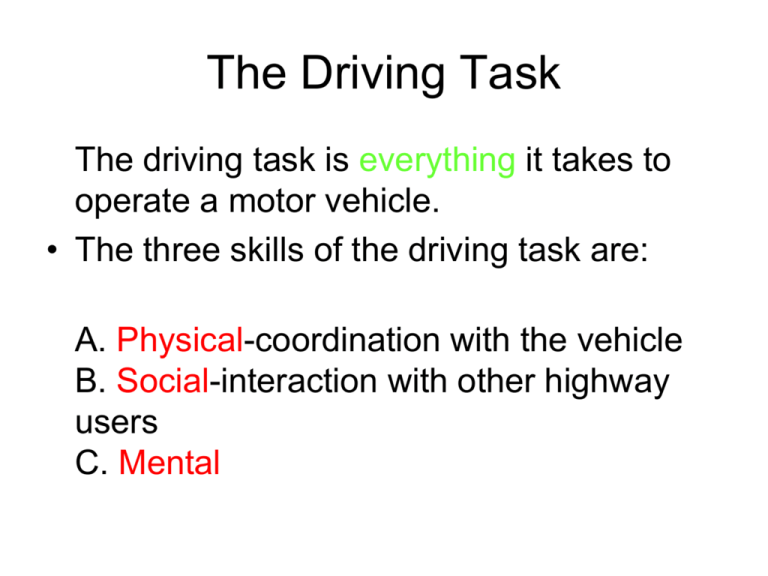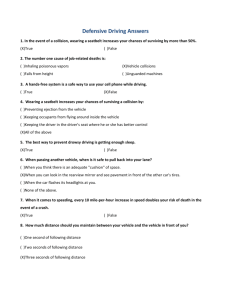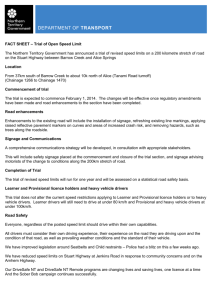The Driving Task
advertisement

The Driving Task The driving task is everything it takes to operate a motor vehicle. • The three skills of the driving task are: A. Physical-coordination with the vehicle B. Social-interaction with other highway users C. Mental Mental Skills are Most Important • There are at least five mental skills: 1. Understanding the motor vehicle 2. Perception based on stored knowledge 3. Understanding traffic laws 4. Judging time/space relationships 5. Concentration on task People are the problem • Of the three components of the highway transportation system, 90-95% of accidents are caused by human errors. • Not the vehicle • Not the highway • People making bad choices. How to Manage Information • The SMITH system. Developed by Harold Smith 50 years ago for truckers, the system helps us organized available information. • There are five steps to the SMITH system • Aim high in steering is looking 12-15 seconds ahead of your vehicle. Not continually, but checking and keeping track of what is happening there. • Keep your eyes moving. Move your sight to critical areas in an orderly visual search pattern. • • • • Check your mirrors as necessary Check your gauge package as needed Check 12 seconds in front of you Check cross traffic as you approach it • Keeping your central vision active. • Get the big picture. Know everything around your vehicle that may effect you. • The persons around you that are eating, talking on a cell phone or texting, changing CDs, reading their mail or whatever. Watch out for STUPID, they are everywhere! • Make sure others see you. Many accidents are caused by inattention. Make sure other highway users see you. Use your lights, horn, even drive a bright colored vehicle. Studies show day time running lights reduce accidents by 7%. High mounted center brake lights reduce rear end collisions by 8%. Because they help others see you. • That is why we have headlight laws when your wipers are on, not to see but to be seen. • The same reason motorcycles have to run with their headlights on. • Leave yourself an out. Make sure to avoid collision traps. Do not leave your safety up to other drivers. You should always be able to get away from other highway users. Always leave an escape path for any mistakes you or others may make. • That includes what is behind you! • Eye lead time is how far you are looking down the road. • When aiming high in steering, you are keeping track of 12-15 seconds in front of your vehicle. While most drivers look only 3-5 seconds down the road, research has shown that 80% of collisions could have been avoided had drivers had one more second to react. • Following distance should be at least two to three seconds behind the vehicle in front under ideal conditions. As the vehicle in front passes a fixed object, your vehicle should not get to that spot for at least two to three seconds. In poor weather or road conditions, increase the time and distances between you and the other vehicles. • Two seconds is under IDEAL conditions. Wet roads reduce traction by 25%, so back off. • I dare you to check your following distance, then check and see what time other drivers are following. • Check your following time on a freeway. It will be less than a 1/3 of a second, not 4 over 40 your text suggests. • Is it no wonder we have so many rear end collisions? I am surprised we don’t have more. Look at the next slide, a normal day on a freeway. These cars are still traveling at 50 plus mph Tailgating is rampant • The best way to deal with a person following you too closely is to increase your following distance so you don’t have to stop quickly. Other ways include: • A. Move over/change lanes. B. Slow down/pull over encouraging them to pass. C. Tap your brake lights to alert the driver behind. D. Signal your turns early/slow down early E. Don't anger the following driver. • We will talk about road rage later. An orderly visual search pattern • An orderly visual search pattern consists of looking at all the traffic information in a systematic fashion. Look 1215 seconds ahead of your vehicle, to the front and sides, scanning for anything that might come in front of your vehicle. Check mirrors on a regular basis. Keep track of all vehicles behind and around you in other lanes of traffic. Thirdly, check your vehicle instruments as necessary. This means knowing what the gauges and controls should be and what to do when a gauge is not reading normally. IPDE. Another way to organize available information • I: Identify. With your eyes moving and getting the big picture, you learn to identify potential hazards in the traffic scene. P: Predict potential conflicts is critical to collision free driving. Many drivers do not realize the risk of a collision until it is too late. Drivers must always be vigilant, predicting "worse case scenarios". D: Decide what to do if the worst case comes true. E: Execute your decision to slow down, change lanes, flash your lights are other actions to minimize the risk of a collision. What do you predict? • Perception is the brain's interpretation of what the eyes see. We interpret based on previous experience and knowledge. That is why experience is critical to perception. • Separating hazards is predicting hazards ahead of you and adjusting your speed or direction to get to them individually instead of all at once. • Compromising lane positions is to change lanes or even moving over to give more clearance between your vehicle and other highway users. Communication is key • Ways to communicate with other drivers include: lane position; horn; lights; hand motions; turn signals; brake lights; even hazard lights. • Don’t make your driving maneuver surprise someone else.









